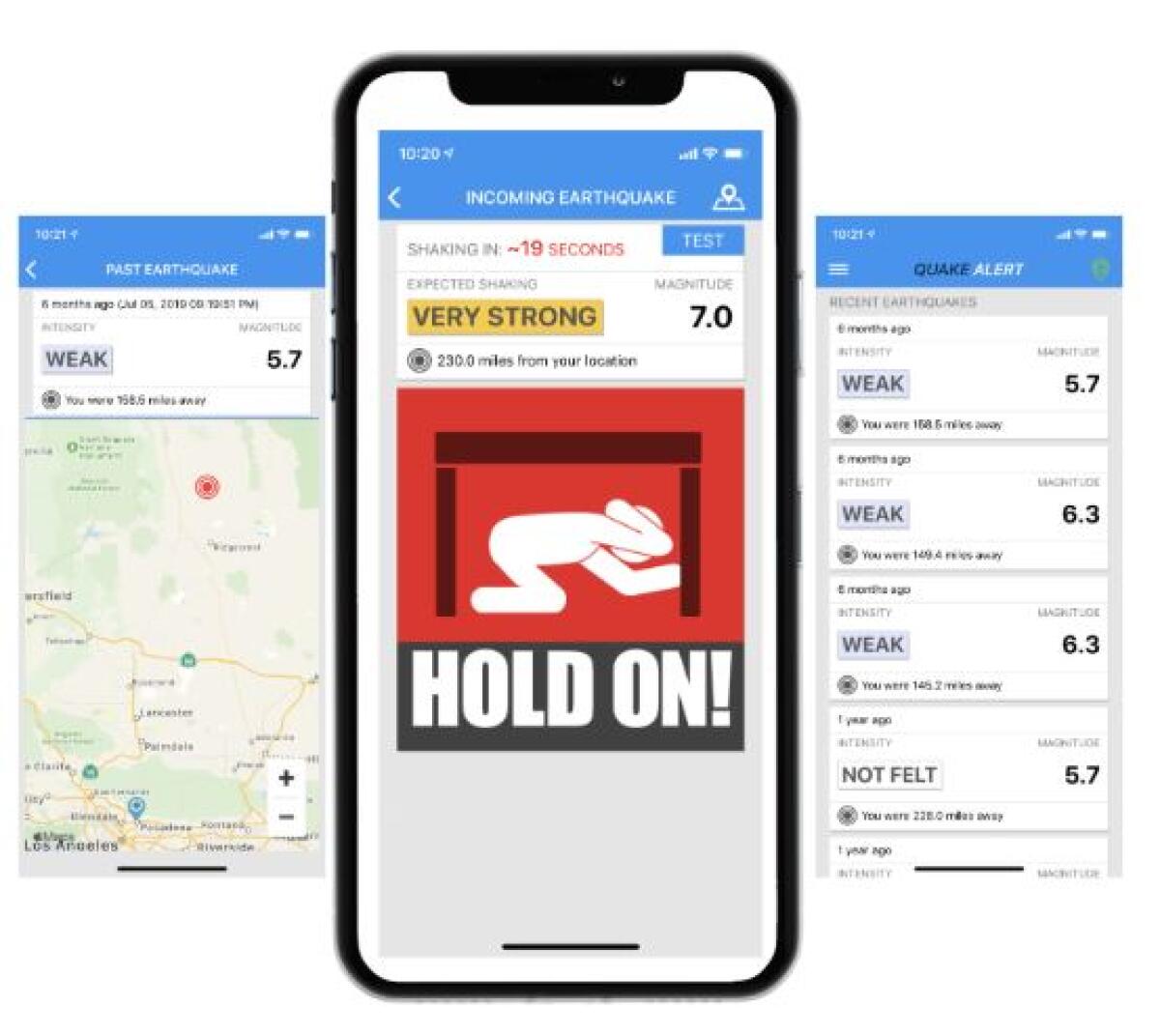California’s new early warning earthquake app features a shaking countdown

- Share via
A new earthquake early warning app for smartphones has been released, offering users across California the ability to see a countdown before shaking arrives.
Available for iOS and Android phones, QuakeAlertUSA also offers the ability for phone owners to individually tailor when the app is triggered — for weak, light or moderate shaking.
The app by Santa Monica-based Early Warning Labs uses the same data source as the other two apps that have been available — the U.S. Geological Survey’s ShakeAlert system, powered by hundreds of earthquake sensors across California. Two other apps are available for earthquake early warning but don’t offer countdowns or the ability to ignore warnings for weak and light shaking; they are UC Berkeley’s MyShake app, which offers statewide coverage, and the City of Los Angeles’ ShakeAlertLA app for users physically in Los Angeles County.
California authorities have also begun to issue alerts via text message, through the Amber Alert-style Wireless Emergency System. Those alerts do not require downloading an app or having a smartphone to receive the apps, but that system may be slower than the apps and is set to go off for only more relatively stronger shaking than the smartphone apps.
The mildest shaking that can trigger an alert for QuakeAlertUSA’s app is weak shaking, or Level 3 on the Modified Mercalli Intensity Scale, defined as felt quite noticeably by people indoors, especially on upper floors of a building, and can cause standing motor vehicles to slightly rock. Some might think the shaking is resulting from the vibrations felt when a heavy truck passes.
This threshold is the same used by ShakeAlertLA and MyShake.
Users of the QuakeAlertUSA can also set the alarm to ring only for more substantial shaking, such as one that’s light, or level 4 for the intensity scale, in which many people feel shaking indoors, and the shaking disturbs dishes, windows and doors, causing walls to make cracking sounds. This is the same threshold used by the state in activating earthquake early warnings through text message.
Finally, users can set the minimum threshold to moderate shaking, or intensity level 5 — enough to awaken many people, break dishes and windows, overturn unstable objects and stop pendulum clocks.
“It’s exciting,” said Josh Bashioum, founder and CEO of Early Warning Labs, of the release of the app. “Our main goal is to save lives.”
Earthquakes need to be at least a magnitude 4.5 for the USGS’ ShakeAlert system to even consider send out warnings to devices that are seeing at least weak shaking, or Level 3 on the intensity scale.
In recent months, slight shaking has triggered alerts in sparsely populated areas. In December, a magnitude 4.3 earthquake ruptured in the mountains between the Central Coast and San Joaquin Valley, causing more than 40 people to receive an alarm. (The app sent out an alert because the initial calculation of the earthquake came in at magnitude 4.8, above the minimum magnitude 4.5 threshold for the event to be considered for a warning.)
And in January, a magnitude 4.6 earthquake in the Mojave Desert caused an earthquake early warning to be sent out by text message over the Wireless Emergency Alert system, directed toward users in a projected zone of light or moderate shaking in a sparsely populated area north of the Barstow area and south of Death Valley National Park.
The countdown feature should be used with caution. People shouldn’t wait around for the seconds to tick down before dropping, covering and holding on; they should do it right away, said USGS ShakeAlert scientist Robert de Groot.
Decent shaking can come even before the countdown hits zero. “Don’t have a false sense of security; earthquakes are very complex. That’s why we’ve been very careful about the countdown issue,” De Groot said.
Institutions across California have launched earthquake early warning systems; including the BART commuter rail system in the Bay Area and the Los Angeles County Metropolitan Transportation Authority, designed to slow trains before shaking arrives; public address systems in some buildings, like L.A. City Hall and a 19-story condo tower in Marina del Rey, are wired to warn residents of incoming shaking through a public address system.
Such a system was installed by Early Warning Labs at Cedars-Sinai Medical Center, where an audible alert is programmed to go out in advance of shaking, saying, “Earthquake, earthquake. Expect shaking. Drop, cover and hold on. Protect yourself now,” said Ryan Tuchmayer, director of emergency management. Hospital staff have been trained on how to react to the alerts, and staff have gone through drills.
The minimum threshold of shaking that will activate a warning at Cedars-Sinai is light shaking, or level 4 on the intensity scale.
Institutional users of earthquake early warnings can set their threshold for alarms or action differently under USGS rules. A company focusing on making sensitive electronic equipment, for instance, may want to take action at even the slightest expected shaking that may not be perceptible to most humans, or intensity level 2.
More to Read
Sign up for Essential California
The most important California stories and recommendations in your inbox every morning.
You may occasionally receive promotional content from the Los Angeles Times.











